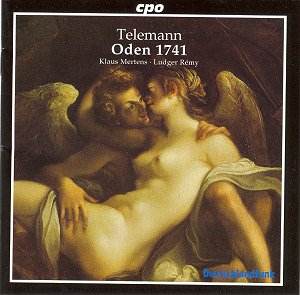The first collection of songs for solo voice
with basso continuo in Germany was published in 1627: the ‘Teutsche
Villanellen’ by Johann Nauwach. For some songs in this collection
he used poetry by Martin Oppitz, whose ‘Buch von der Deutschen
Poeterey’ led to a reform of German poetry, and as a result played
an important part in the increasing popularity of the (secular)
solo song. During the 17th century composers like Heinrich Albert,
Adam Krieger and Andreas Hammerschmidt composed that kind of song,
which was in particular sung in student’s circles.
At the end of the century, though, the form of
the solo song declined. On the one hand the Italian solo cantata
became increasingly popular and overshadowed the song. On the
other hand composers started to publish opera arias as solo songs,
which were too difficult for non-professional singers to sing.
In the first decades of the 18th century composers
even looked down on the solo song, according to the music critic
Johann Adolf Scheibe, a close friend of Telemann. But in the 1730s
things started to change. The ideal of music being ‘simple’ and
‘natural’ constituted the breeding ground for the solo song -
generally called the ‘Ode’ - which made a comeback with several
publications of songs by Sperontes (1736) and Gräfe (1737).
But they were criticised for their lack of quality, in particular
by Scheibe and also by Johann Mattheson.
With his ’Vier und zwanzig, theils ernsthaften,
theils scherzenden, Oden’, published in 1741, Telemann wanted
to show how ‘Odes’ should be composed. He formulated some standards
‘Odes’ had to meet: they should have "easy melodies comfortable
for almost every throat", operatic embellishments should
be avoided and ‘distinguishing marks’ like commas, question and
exclamation marks should be strictly observed.
The fact that Odes were strophic meant that the
music had to fit all stanzas. As a consequence the possibilities
to express single words were limited. This circumstance didn’t
make composing Odes very easy, as Telemann himself admitted.
As texts Telemann used poems by some contemporary
poets, like Friedrich von Hagedorn and Johann Matthias Dreyer.
They are about the usual subjects like wine and love or contain
pastoral themes.
Most of them reflect the ‘anacreontic’ ideals.
‘Pleasure’ was the goal of life, which meant first and foremost
‘a quiet life’, free from pain, fear and obsessions. Ode No. 7
lists the ‘True Virtues’: he who "elevates himself without
pride", "ridicules the power of prejudice", "separates
himself from the mob", "desires only what he has",
"whom cares don’t sadden", "He who’s all to himself,
who easily forgets evil, who persists through madness and doubt,
whom no dumb prosperity represses, who maintains his peace in
the midst of storms certainly has the highest good".
"The Epicurean motto ‘live a secluded life’
points to the individualistic, contemplative element in this philosophical
current, which found its expression in convivial retirement with
a small circle of friends" (Ralph-Jürgen Reipsch in
the liner notes). But some poems also contain moralistic elements.
Ode No. 18 (The Merry Shepherd’s Life) ends like this: "My
mind content with God need not strive for any treasures because
I in my poor life am richer than an emperor". Or in Ode No.
14 (The Meagre Meal): "And if God grants me to my end, my
plain fore, my daily bread, then I’ll kiss his hands for it, then
I’ll never complain about need." The moralistic tendency
and the epicurean ideal come together in Ode No. 20, which is
called ‘Sufficiency’: one should be satisfied with what God gives;
that way one can be free of obsessions, like money and property.
Telemann’s songs may be ‘plain’ and ‘natural’,
they are certainly not ‘simple’ in the negative sense of the word.
Broad intervals and irregular rhythms are present in several of
the Odes. The range of the vocal part is indeed in the ‘middle
of the road’ which Telemann formulated as a standard. But with
all the limitations the Odes were subjected to, the 24 Odes are
anything but predictable and simplistic. The melodic invention
Telemann displays in these Odes is astonishing.
The composition of these Odes may not have been
very easy, as Telemann admitted, neither is the interpretation,
one should add. For professional musicians, used to ornamentation,
to express the text and realise a maximum of variation it isn’t
always easy to find the right way of performing this kind of ‘simple’
music. They have to find the ‘middle road’ between doing too little
and doing too much. Some insist that there should be no ornamentation
at all in the performance. Klaus Mertens thinks otherwise: to
the ornaments Telemann has written down he has added some of his
own, but always tasteful and modest. He also stresses single words,
which I feel in some cases is a little over the top considering
the character of these songs. Ludger Rémy nicely differentiates
between the stanzas in his realisation of the basso continuo.
This is an important recording, since it breaks
relatively new ground. It is also a very satisfying recording.
Perhaps these songs are not suitable to be listened to in succession,
but both artists have done everything possible to keep the listener’s
attention. Telemann, according to his own testimony, has composed
about 700 airs and songs, so there is still work to be done...
Johan van Veen

